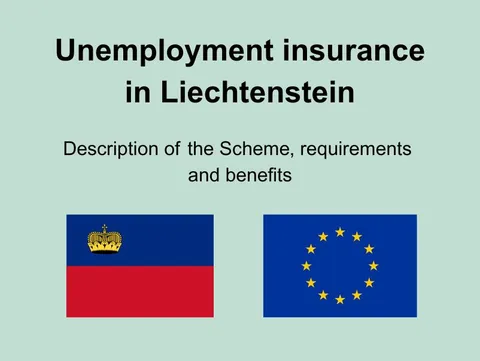EU
Liechtenstein
Unemployment
Insurance
Unemployment Insurance in EU->Liechtenstein
Unemployment insurance in Liechtenstein
This article describes the benefits you may receive in the event of unemployment. The following benefits are addressed:
- jobseeker's allowance (unemployment benefit or allowances)
- benefits in the case of partial unemployment
- short-time employee benefit
- insolvency benefit.
In what situation can I claim?
The receipt of benefits is generally subject to the condition of unemployment or partial unemployment (short-time work) for which you are not to blame.
In the case of self-inflicted unemployment, payment of the daily allowance ceases for up to 60 days. However, after this period you are once again entitled to unemployment benefit.
What conditions do I need to meet?
Insured persons are entitled to receive unemployment benefit if they:
- report to the Office of Economic Affairs in person for a review by no later than the first day on which they are applying for unemployment benefit and apply for the benefit and follow the legal control regulations from then on
- are available for job placements (e.g. in a position and prepared to take up any reasonable kind of work)
- have a minimum insurance period of 12 months, i.e. in the last 2 years before unemployment began, they were in employment and therefore paid unemployment insurance contributions or were exempt from the contribution obligation due to illness or education
- are not entitled to an old-age pension
- are resident in Liechtenstein or are staying in Liechtenstein as part of a temporary activity (i.e. working in Liechtenstein as an employee for an employer with a registered office or branch in Liechtenstein)
- have suffered a creditable loss of work.
What am I entitled to and how can I claim?
Unemployment benefit (unemployment allowance)
The unemployment allowance amount depends on the wage, age and child maintenance obligations of the insured person. It is 80 % of the gross wage of the unemployed person and reduces to 70 % for insured persons who have no maintenance obligations, who receive a full daily allowance and are not disabled. The maximum insured annual salary is CHF 126,000.00.
The duration for claiming the unemployment allowance depends on the person's age and contribution period among other factors. The person is entitled to claim within a period of 2 years: 260 daily allowances for a contribution period of 12 months, 400 daily allowances for a contribution period of 18 months and from the age of 50, 500 daily allowances for a contribution period of 22 months and claiming an invalidity pension for a disability level of at least 40 %, 130 daily allowances for persons exempt from contributions, 200 daily allowances for persons under 25 and without a child maintenance obligation.
In the event that obligations are breached (e.g. obligations to cooperate), no benefits are granted for a specific period. Days within this are referred to as ‘suspension days’.
Benefits for partial unemployment (short-time work allowance)
Employees in the following professions are entitled to weather-dependent short-time work allowance: bricklayers, carpenters, plasterers, quarry workers, road builders, roofers, pavers, stonemasons, tilers, landscape gardeners, plumbers, flushers, river and avalanche engineers, mudslide and landslide workers (rock fall workers) and foresters provided that the latter are not employed in an offshoot of a farm. Employees performing other work may be equated with those performing the jobs listed above if their partial unemployment is associated with one of the professions mentioned.
Other benefits
In the event of the employer's insolvency (bankruptcy) or unsuccessful foreclosure (execution), the insured persons will receive an insolvency benefit from unemployment insurance for the months (time limit) in which the employee has worked and the employer no longer paid wages.
Jargon busters
- Short-time work: short-time work is when working hours are reduced or there is a temporary suspension of the work for economic or weather-related reasons. In this case, a short-time work allowance is paid as a daily allowance.
Know your rights
The links below provide additional legal information.
- Unemployment guide (pdf, in Deutsch)
- ALV - Guide about Unemployment compensation (ALE)
Who do you need to contact?
Office of Economic Affairs
Poststrasse 1
Postfach 684
9494 Schaan
LIECHTENSTEIN
Tel. +423 2366871, +423 2366889
Email: info@avw.llv.li
This page was last updated in 2024.
- Unemployment insurance in Europe →
Unemployment Insurance in Liechtenstein
You might also be interested in:
⇒EU social security coordination
⇒Unemployment Insurance in the Nordic countries
Key points of EU Unemployment Insurance coordination
- Transferring periods of work and insurance between EEA countries As an EU citizen you can transfer acquired rights from Unemployment Insurance when moving between EU/EEA contries. In this way it may be easier to become entitled to unemployment benefit in the country you move to.
In the vast majority of the Member states the aggregation rule become fully applicable as soon as you starts to work in the country. However in Denmark, Belgium and Finland you must work some period there before you can use the aggregation rule.
You need a PD U1 document in the country you leave or if the involved countries use electronically exhange (EESSI) there will be issued a SED U002. The countries who issues the highest number of PD U1 documents are Germany, Austria, Switzerland and the Netherlands. The countries who receives most PD U1 documents are Lithuania and Italy. - Transferring unemployment benefits Under certain conditions you can go to another EU country to look for work and continue to receive your unemployment benefits from the country where you became unemployed. The period you can export your unemployment benefits varies from 3 to 6 months in the different Member states.
You have to apply for a PD U2 document in the country you leave, or if you haven't done that the institution in the receiving country must request a SED U008 from the competent institution in your last country.
The countries who issues the highest number of PD U2 documents are Germany, Switzerland, the Netherlands and Denmark. Poland is the country who receives by far most PD U2 documents. - Unemployment benefits coverage According to OECD the net replacement of income after 2 months of unemployment, for a single person without children whose previous in-work earnings were 67% of the average wage varies from 33 percent (Ireland) to 91 percent (Belgium). Read more here..
- Having residence in another EU country than where you work? According to EU social security coordination rules you must only be insured against unemployment in one country at a time. As a generel rule this country is where you work.
In Member states who have compulsory insurance, you will automatically be covered when you start working there.
However you may be insured by your country of residence if you are posted to a EU/EEA country or work in two or more EU/EEA countries at a time. In these situations you can not your self decide where to have unemployment Insurance, but you (or your employer) must apply for a PD A1 document which states in which country you are covered by social security, including Unemployment Insurance. Special rule also apply for cross-border workers ("frontier workers"). - Third-country Nationals working in EU/EEANON-EEA citizens are covered by Unemployment Insurance in the EU countries who have compulsory Unemployment Insurance. In countries with voluntary Unemployment Insurance (Denmark, Sweden and Finland) third-country nationals can become member of an Unemployment Insurance Fund.
In the most countries Third-country nationals can also use the EU Coordination rules when moving within EU/EEA (however not in Denmark, Iceland, Liechtenstein, Norway and Switzerland).
Third-country nationals in short-tem working relations often faces problems with actually get Unemployment benefits, even though they have contributed to the system. This is due to the fact that one normally need a residence permit which allow one to take any job, and also because of a qualifying period in most countries between 6-12 months.

